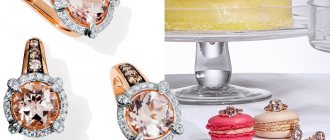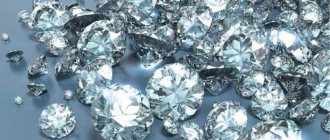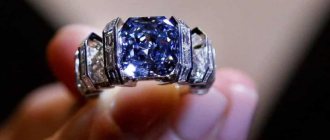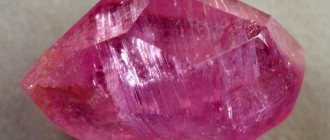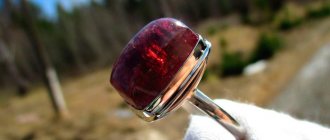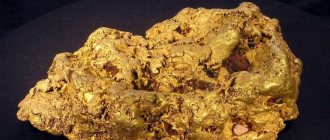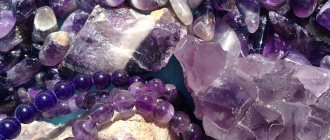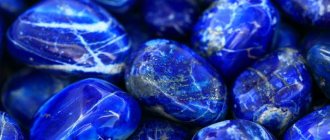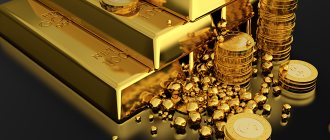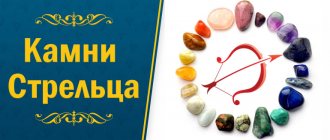Today, the jewelry industry has reached such a level that fashionable and beautiful products are made from almost any material. Conventional precious stones often fade into the background, giving way to more budget-friendly semi-precious and ornamental stones. But not all customers know how the inserts differ from each other and why prices vary so much for minerals that are similar in appearance. To understand this, let’s take a short excursion into the history of the jewelry industry and consider each type of insert separately.
Gems
The most expensive and most valuable inserts. What is the reason for the high cost of such minerals? Let's figure it out in order.
The first thing to consider is that gems are natural minerals formed in a complex way in the earth’s crust. Accordingly, a gemstone can be called such only if it is rare in nature .
Jewelry with cognac diamonds in the “Chocolate” collection
Let us present some statistical data from world practice. The relative cost of mining the most expensive stones as a percentage of the cost of total mining at the beginning of the 21st century was as follows: emeralds - 43, rubies - 14, opals - 10, sapphires - 6, jadeite - 6, turquoise - 5, other colored stones - 16%. This shows that the high cost of precious stones is due, first of all, to the complexity of their extraction.
What other indicators can identify a gemstone among all the others?
Hardness _ The mineral should not be exposed to external influences - scratched or chipped. In Russia, in accordance with the Federal Law “On Precious Metals and Precious Stones,” this list includes natural diamonds, emeralds, rubies, sapphires, alexandrites, and pearls. Unique amber formations are also considered precious stones. From this we see that its high cost is quite understandable.
In addition, the degree of its fashionability . Simply put, the more an accessory falls under the definition of a “fashion trend,” the higher its cost.
The world of precious stones is very large and, unfortunately, confusing, especially when viewed superficially. At the moment, over 2.5 thousand minerals are known, but only a little more than a hundred of them are valuable from the point of view of the jewelry industry and decorative arts.
It is quite difficult to understand the intricacy of varieties of precious, semi-precious and ornamental stones, but there are also valuable natural formations that are not minerals. Therefore, within the framework of this publication, several approaches to the classification of valuable minerals and natural formations will be considered.
Magic properties
Ornamental stones serve not only in everyday life or for decoration. Each of them is believed to have magical properties:
- Jasper protects from dark forces and the bad influence of evil people. This is its similarity to agate. Sorcerers loved to store things in jasper boxes. In ancient temples, floors made from this mineral are sometimes found, as it keeps demons out. If you store jasper products in your apartment, the atmosphere of your home improves.
- Jade has rare magical powers . In China, they believe that the gem embodies justice, wisdom, mercy, courage and honesty. The mineral does not like people who harbor negative emotions, so it is recommended to be worn by prepared, spiritually developed individuals. The gem protects from evil, preserves the family and helps in business. However, the thoughts of the owner of the stone must be noble, only then will jade become a good amulet.
- Malachite helps strengthen the connection with the guardian angel and develops intuition . In Ancient Rus' they believed that the gem gave the ability to better understand animals. Malachite is sometimes recommended for children.
What types of gems are there?
The names of precious stones and minerals (which, in fact, are the same thing) are presented differently in different classifications, since a unified system has not yet been developed. From a generally accepted point of view, only the most beautiful, rare and expensive minerals and other natural formations can be considered precious stones.
According to Article 1 of the Federal Law of March 26, 1998 No. 41-FZ, officially precious stones are exclusively diamonds, rubies, emeralds, alexandrites and sapphires, as well as pearls of natural origin, that is, organics. Amber is also sometimes included here, but with certain unique features - special inclusions, heavy weight, and so on.
Ring from the “Diamonds of Yakutia” collection in Sunlight
However, there are also nuances here: precious stones in jewelry look very impressive and cost accordingly. But very small or defective minerals lose a lot in value, while semi-precious semi-precious gems of large sizes and rare colors can be equal in value to first-order precious stones.
The science that studies precious stones is called gemology. This is a special section of mineralogy devoted to precious, jewelry, semi-precious and ornamental stones.
Table of precious stones according to the classification of the prominent Soviet and Russian mineralogist E.Ya. Kievlenko seems the most logical and easy to understand. Based on it in the light of modern realities, Doctor of Geological and Mineralogical Sciences E.P. Melnikov proposed an improved version of the classification.
Without going into detail, there are four groups of valuable minerals:
- Gems. Diamond, classic blue sapphire, ruby, alexandrite, emerald and natural sea pearls.
- Jewelry stones. They are divided into four orders. Among the most famous: sapphires of fancy colors, spinel, opals, tanzanite, various types of beryl and corundum (except precious ones), tourmalines, zircons, garnets, freshwater and sea cultured pearls, amethyst, aquamarine, citrine, tiger and cat's eye, apatite, mother of pearl, certain types of quartz and others.
- Jewelry and ornamental stones. Malachite, turquoise, jadeite, lapis lazuli, pink and smoky quartz, jasper, ordinary opals, rock crystal, special grades of jasper, jade, agate, chrysoprase and others.
- Ornamental stones. Jasper, marble onyx, jet, goldite, obsidan, certain types of granite and other ornamental materials of mineral origin.
In addition to pearls, the classifier also includes other materials of organic origin. These are corals, mammoth and ivory. They are considered jewelry and ornamental stones.
Price for semi-precious stones
You can purchase jewelry and nuggets only in trusted places. Due to the fact that many fakes are supplied today, there is a chance that you will buy yourself a useless piece of jewelry that will not have all those magical and healing properties. Natural stones are expensive, especially some types: turquoise, jade, ruby, moonstone, amber. Approximate cost of jewelry:
| Name of the stone | Price, rubles |
| agate | from 700 |
| aventurine | from 400 |
| alexandrite | from 30000 |
| turquoise | from 1500 |
| heliodor | from 2000 |
| pomegranate | from 800 |
| jade | from 300 |
| quartz | from 200 |
| lapis lazuli | from 600 |
| malachite | from 1500 |
| nephritis | from 1500 |
| obsidian | from 1000 |
| onyx | from 200 |
| opal | from 1000 |
| sardonyx | from 300 |
| cornelian | from 300 |
| tourmaline | from 1000 |
| chalcedony | from 600 |
| chrysoberyl | from 1000 |
| amber | from 2000 |
The most expensive gems
We will not repeat the above: the most expensive in the ranking of precious stones in terms of value are the last five positions described above. These are gems of the first order and the highest value according to any classification.
But you need to understand that it is impossible to compile an objective list of stones by value: the cost of a carat of a mineral depends not only on its chemical formula, but also on purity, transparency, size, color, presence/absence of defects and other parameters.
Therefore, in this nomination we will present the rarest and most expensive minerals that go beyond generally accepted standards. So, here is a list of truly unique stones, valued at fortunes:
- Tsavorite. Jewelry garnet is yellowish-green in color. A carat costs about 3-5 thousand US dollars.
- Sapphire. An unheated stone of pure blue color is estimated at a minimum of 4.5-6 thousand dollars/carat.
- Red spinel. It is considered one of the fastest growing minerals in price: the cost is 6-8 thousand dollars per carat.
- Demantoid. Another green garnet, but a piercing pure color. Ural demantoid costs about 10 thousand dollars/carat.
- Paraiba. Neon blue tourmaline that glows in the dark. Average quality stones cost 8-12 thousand dollars/carat.
- Emerald. Flawless pure emeralds are extremely rare. The cost of a carat of high-quality unoiled emerald starts from 10-13 thousand dollars
- Padparadscha. The sapphire is an incredible orange-pink color. Cost – 10-12 thousand dollars/carat.
- Alexandrite. The price of this stone ranges from 10-37 thousand dollars/carat. The most expensive are those mined in Russia.
- Ruby. A clean large stone of the top color “pigeon blood” is estimated at 15-25 thousand dollars/carat.
- Jade. The rarest transparent jadeite, known as “imperial”, costs at least 20 thousand dollars per carat.
- Diamond. The cost of a high-quality colorless diamond is about 15 thousand dollars per carat. A blue diamond costs about 30-50 thousand. And the most expensive gemstone in the world is the red diamond: a carat is estimated at 500 thousand - 1 million dollars.
Paraiba Tourmaline
Sandstone is an incredibly durable and practical material.
A natural stone, for whose qualities it is called elite. And not in vain, because it looks natural, has extreme strength and elegant texture, which makes it indispensable in decorating various areas and creating a unique exterior. There are different types of sandstone, they are distinguished by their mineral composition:
- Tuffaceous - have a volcanogenic composition.
- Oligomicts - contain a lot of quartz.
- Polymictic - Consists of fine-grained detrital cement and fragments of various rocks.
- Monomictic is a type of quartz sandstone containing more than 90% clastic rocks.
Sandstone is used in construction and facing works. Its crumbs, which are used in the production of various varnishes and glass, are also highly valued. Used to create sidewalks, paths, and other decorative landscape compositions. Our website contains a list of stones, photos, names of types of sandstone for any type of work performed.
Sandstone paving tiles
What is the difference between precious and semi-precious
There are no objective parameters that distinguish precious stones from semi-precious ones. The main criterion in this case is the price: semi-precious ones are inexpensive, precious ones are not accessible to everyone.
In the classification of the All-Russian Research Institute of Jewelry Industry there is no concept of precious and semi-precious stones at all: they can be jewelry, semi-precious and jewelry-precious.
Precious stones mined in Russia are highly valued on the world market. Moreover, the Russian Federation has deposits of almost all precious minerals, with the possible exception of rubies.
Boulder is an excellent decoration for a summer cottage
A boulder is a large piece of rock presented in the form of a huge stone. There are different names for natural stones of this type, which, due to their durability and specific texture, have a wide range of applications, for example:
- Facing works.
- Finishing facilities.
- Decoration of gardens, summer cottages.
- Creating a foundation.
There are also different names for natural stones of this type, which depend on the rock, texture and size. You can easily familiarize yourself with them on our website and choose the ideal option for your needs.
Appearance of a decorative boulder
Classification of stones by properties
The classification of precious stones takes into account all kinds of physical, optical and other characteristics. The most obvious characteristic of gemstones is their weight. With all other qualities being equal, a carat of a large mineral will cost more than a similar unit of a small one (sometimes by several times).
Carat is a unit of weight of precious stones, accepted by jewelers all over the world. One carat is only 0.2 grams!
All other properties of precious stones can be combined into the following broad groups:
- Rarity. The rarer the mineral, the higher its value. It’s enough for a large deposit to be depleted, and the stone immediately soars in price.
- Feeling. Tactile sensations when touched (“soapiness”, slipperiness, etc.).
- Density. The denser the stone, the heavier it is. Zircon is even heavier than diamond. The lightest is amber.
- Hardness. Here it is appropriate to mention the Mohs scale, which grades the hardness of substances according to a ten-point system, from diamond (10) and corundum (9) to talc. Test - surface scratching.
- Strength. A very hard stone may not be very durable and will easily crack under physical stress. Not too hard jade is very difficult to split due to its high viscosity, and zircon crumbles instantly.
- Cleavage. The description of this characteristic is quite difficult: it is the “behavior” of the stone when splitting (in which directions it splits). It is fundamentally important when cutting.
- Electrification and polarity. For the jewelry industry, these parameters are not important.
- Transparency. Gemstones are usually transparent or translucent. The purer the stone, the more valuable it is.
- Color. Multi-colored stones can be more valuable or cheaper than their classic counterparts. Examples were given above.
- Shine. Can be diamond, glass, silky, mother of pearl and so on.
- Light refraction. A characteristic that is fundamentally important when choosing a cut.
- Dichroism and polychroism. The ability of a stone to change color depending on the angle and intensity of light.
- Asterism. The effect of a “star” inside the stone when hit by light.
- Luminescence. The ability to glow, characteristic of diamonds, rubies, jade and other stones.
- Defectiveness. Presence, location, type and number of various defects.
- Quality of cut. The value of the mineral directly depends on the quality of the cut.
- Ennoblement. A stone with good natural characteristics will always cost more than its improved (heated, oiled, painted, etc.) counterpart.
Pebbles - a stone that will transform any garden
Pebbles are one of the oldest types of stone. It consists of fragments of various rocks, carved by water to a smooth structure and rounded shape. There are several types of it: river pebbles, sea and sand. The name of the stones with photos can be found on our website. Each type is often used by architects and designers in decorative and facing works, including:
- Filling seams and joints.
- Paving sidewalks and paths.
- Facing and decoration of various objects.
Structure and appearance of sea pebbles
How to distinguish precious stones from artificial analogues
Artificial gemstones have the same composition as their natural counterparts. Moreover, they are, as a rule, of higher quality and purer than their natural counterparts. Various valuable crystals are grown under artificial conditions: diamonds, emeralds, rubies and others like them.
However, synthetic stones are much cheaper than natural ones (sometimes hundreds or even thousands of times). And this is explained by the fact that people tend to want to own something especially exclusive.
Almost all minerals remain cool for a long time. A fake made of glass or plastic quickly heats up in your hands. In this way, it is impossible to distinguish a precious stone from a non-precious one, but a crude imitation will immediately give itself away.
You need to understand that synthetic minerals are not fakes, that is, imitations (double stones or ordinary glass). If you buy a product in a large jewelry store, the chance of purchasing an artificial analogue or imitation without knowing it is surely close to zero. They simply won’t risk their reputation.
Gold ring with synthetic amethyst
Gold ring with natural amethyst
A non-professional will not be able to determine whether a gemstone is precious or not simply by eye. It is best to beware of buying jewelry second-hand or from small, dubious shops.
But if you somehow get your hands on a dubious specimen, an examination and evaluation of stones is at your service, which can be ordered at any jewelry workshop. Gross fakes are identified immediately, visually; in complex cases, more specific methods are required.
Limestone is an indispensable solution for decorative and facing works
Limestone is a sedimentary rock that contains calcium carbonate in crystals of different sizes. If the stone consists mainly of fragments of shells of marine life, it is called shell rock. Also, after going through certain metamorphoses, it has the ability to transform into marble. There are various stones, a list of whose names is on our website. Each of them is well suited for different jobs. Eg:
- Thin layers - used for cladding buildings, bridges, and paving sidewalks.
- Layered limestone is a decorative material used by architects and designers.
- Construction limestone is used in the construction of tall buildings and large objects due to its high strength and wear resistance.
Building limestone blocks
Interesting facts about gemstones
And now some fun facts:
- The rarest gemstone in the world is grandidierite. At the moment, only eight copies are known.
- One of the most impressive collections of precious stones in the world is the Diamond Fund in the Kremlin Armory, in Moscow.
- The hardest gemstone is, naturally, diamond. It is the hardest naturally occurring substance on Earth.
There are not so many deposits of precious stones in nature, these minerals are expensive, and not everyone can afford such luxury. Don’t be upset about this: only an expert can distinguish an artificial diamond or emerald from its natural counterpart. In addition, many semi-precious stones in a classy design look no less advantageous than prohibitively expensive top-end gems.
15.02.21
Paving stones are ideal for creating road surfaces
Paving stones are one of many types of hard road surfaces. Often used in paving roads or sidewalks. Architects and designers use it in cladding and decorative works. With the help of a competent approach, you can perform many operations, such as:
- Pave the road, sidewalk.
- Decorate the house, cottage.
- Carry out facing work.
- Emphasize exterior elements on the site
A description of the type of stone, name and characteristics are on our website, so you can easily find the option you need.
Sidewalk paved with paving stones
Flagstone is an indispensable material for construction and cladding
Flagstone is a stone that is a thin slab.
Example of wall cladding with flagstone
Various forms make it indispensable in decorative works. With it you can ideally:
- Decorate the walls.
- Cladding the building.
- Improve the fireplace or fountain.
- Pave a path or sidewalk.
Our website presents various stones, types and names with photos. This information will help you easily find and select the right colors and shapes, thanks to which you can create a unique exterior in your garden.
